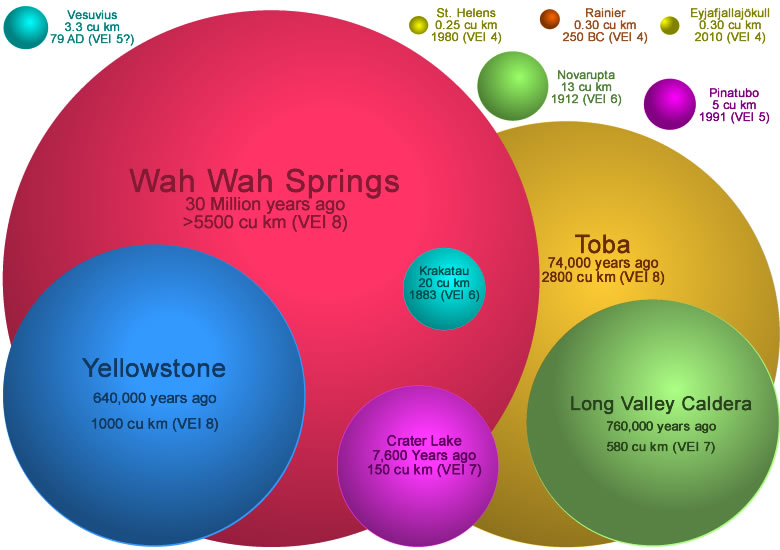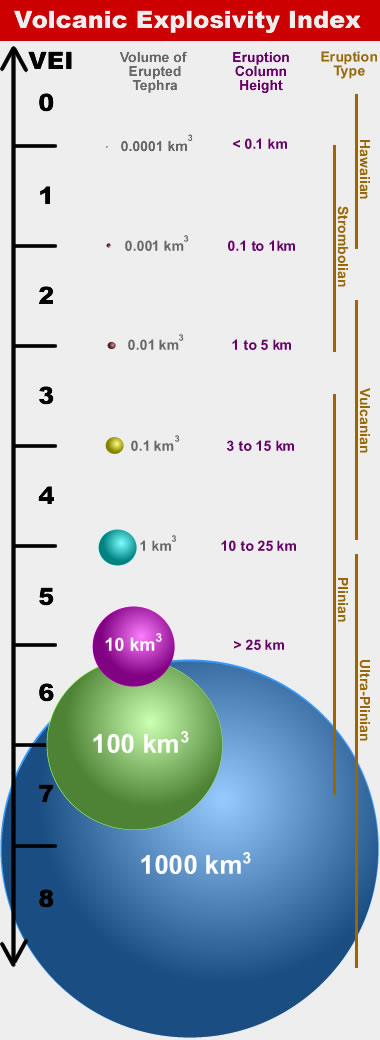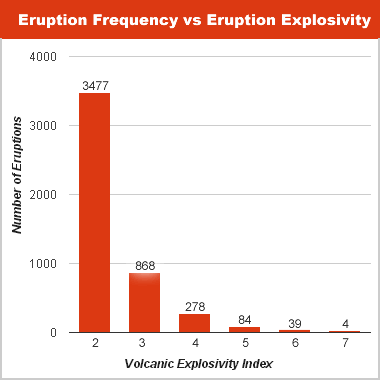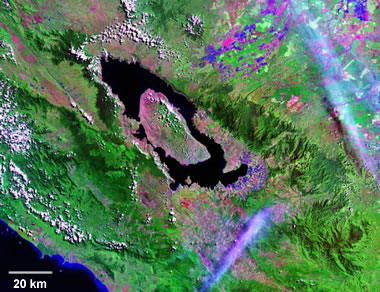Volcanic Explosivity Index (VEI)
Some volcanic eruptions are thousands, or even a million times more explosive than others.

| The spheres in the illustration above represent the volume of erupted tephra for some of the most widely known explosive volcanic eruptions. Although most people believe that eruptions such as Vesuvius (79 AD - the Pompeii eruption), Mount St. Helens (1980) and Mount Pinatubo (1991) were enormous, they are very small compared to other documented eruptions such as Toba, Yellowstone or Long Valley Caldera. |
Measurement Scales for Natural EventsMeasuring the size or strength of natural events has always been a challenge for natural scientists. They developed the Richter Magnitude scale to estimate the amount of energy released by an earthquake, the Saffir-Simpson scale to estimate a hurricane's potential, and the Fujita scale for rating the intensity of hurricanes. These scales are valuable for comparing different events and for understanding the amount of damage that events of different size can cause. Measuring the strength of a volcanic eruption is more challenging than collecting wind speed data or measuring ground motion with an instrument. Volcanic eruptions produce different types of products, have different durations and develop in different ways. There is also a problem that some eruptions are explosive (rock materials are blasted from the vent), while other eruptions are effusive (molten rock flows from the vent). Measuring Explosive EruptionsChris Newhall of the United States Geological Survey and Stephen Self of the University of Hawaii developed the Volcanic Explosivity Index (VEI) in 1982. It is a relative scale that enables explosive volcanic eruptions to be compared with one another. It is very valuable because it can be used for both recent eruptions that scientists have witnessed and historic eruptions that happened thousands to millions of years ago. The primary eruption characteristic used to determine the volcanic explosivity index is the volume of pyroclastic material ejected by the volcano. Pyroclastic material includes: volcanic ash, tephra, pyroclastic flows and other types of ejecta. The height of the eruption column and the duration of the eruption are also considered in assigning a VEI level to an eruption. Steps of the VEI ScaleThe VEI scale begins at 0 for eruptions that produce less than 0.0001 cubic kilometer of ejecta. Most of these eruptions are very small in size. However, some of them are "effusive" rather than being "explosive". Effusive eruptions are characterized by lava flowing from the vent instead of ejecta being blasted from the vent. Eruptions rated at VEI 1 produce between 0.0001 and 0.001 cubic kilometers of ejecta. Above VEI 1, the scale becomes logarithmic, meaning that each step in the scale represents a 10X increase in the amount of material ejected. VEI 2 eruptions produce between 0.001 and 0.01 cubic kilometers of ejecta. VEI 3 eruptions produce between 0.01 and 0.1 cubic kilometers of ejecta. The progression of the scale from VEI 0 to VEI 8 is shown in the diagram at right. With each step in the scale representing an explosivity increase of 10X, a VEI 5 is roughly ten times more explosive than a VEI 4. Two steps of the scale is an increase of 100X in explosivity. For example, a VEI 6 is roughly 100 times more explosive than a VEI 4. A VEI 8 is one million times more explosive than a VEI 2. All of this is based upon ejecta volume. Because each step of the scale is a 10X increase in material ejected there is an enormous difference in the size of an eruption on the low end of a step and an eruption on the high end of a step. For this reason, a "+" is often added to eruptions that are known to be on the upper end of their step. For example, the eruption of Katla in Southern Iceland on October 12, 1918 was rated at VEI 4+ because the eruption was a very strong VEI 4. What Eruption Has the Highest VEI?Forty-seven eruptions have been rated VEI 8 because they are thought to have produced an amazing 1,000 cubic kilometers or more of ejecta. This would be a mass of uncompacted ejecta ten kilometers in length, ten kilometers in width and ten kilometers deep. Eruptions at Toba (74,000 years ago), Yellowstone (640,000 years ago) and Lake Taupo (26,500 years ago) are three of the 47 VEI 8 sites that have been identified.The VEI 8 eruption with the greatest volume of ejecta known to have occurred in the United States, and possibly in the world, was at La Garita Caldera in southwestern Colorado about 28 million years ago. There, the Fish Canyon Tuff has an original estimated volume of about 5,000 cubic kilometers! Eruption(s) at the Paraná and Etendeka traps igneous province had an eruptive volume of over 2.6 million cubic kilometers. However, these are thought to be effusive eruptions producing fluid basalt lava rather than explosive eruptions producing ejecta. The Paraná and Etendeka eruption(s) occurred about 128 to 138 million years ago. Their lava flows span from eastern Brazil onto the western portions of Namibia and Angola. They occurred when Africa and South America were connected. The Frequency of Large Eruptions
The bar graph in the right column of this page summarizes the frequency of eruptions with various VEI ratings using data from the Global Volcanism Program of the Smithsonian Institution for eruptions that occurred between about 10,000 years ago and 1994. Only four eruptions of VEI 7 have been documented but over three thousand VEI 2 events have occurred. Fortunately, very large eruptions are very rare events. Estimating Ejecta Volumes
With present day eruptions observers can compile ash thickness reports from many different locations and create a contour map of ash thickness. This data can be used to estimate the volume of ejecta. Accurate estimates become more difficult when the eruption occurs in a remote area and very difficult when the eruption occurs on an island that is a great distance from other islands or land masses. In these situations the size of the eruption cloud and the duration of the eruption can be combined with ash deposit data to assign a VEI rating. Similar estimation problems occur in calculating ejecta volumes for ancient eruptions. Ejecta is easily eroded and often covered by younger materials. In these situations "best estimates" must be made. When assigning a VEI number is difficult a question mark is often added to the number to indicate uncertainty. For example the Global Volcanism Project lists the VEI of the October 24, 79 AD eruption of Italy's Vesuvius as 5? because insufficient data is available to be certain about the number. Why Does the Scale Stop at VEI 8?The largest explosive eruptions that have been documented to date have been rated at VEI 8. Could eruptions larger than Toba, Yellowstone and other VEI 8 events occur? Does Earth have the ability to produce a blast capable of launching the 10,000 cubic kilometers of ejecta needed to rate a VEI 9 eruption? It is possible that evidence for a VEI 9 eruption exists and is buried in the geologic record. Eruptions that large would be very rare events but it is impossible to say that eruptions that large have never occurred. If an eruption that large were to occur in the future it would be a significant threat to life on earth. Contributor: Hobart King http://geology.com/stories/13/volcanic-explosivity-index/ | 



| ||||||||||||||||||||||||||||||||||||||||||||||||||||||||
--
__._,_.___
No comments:
Post a Comment